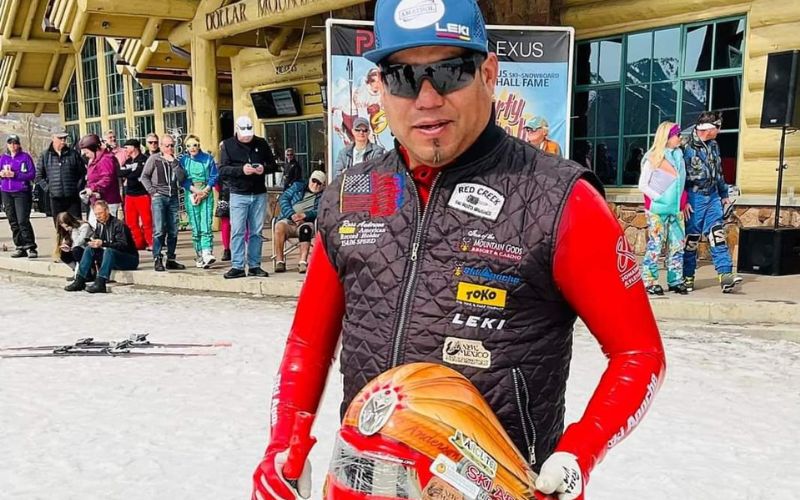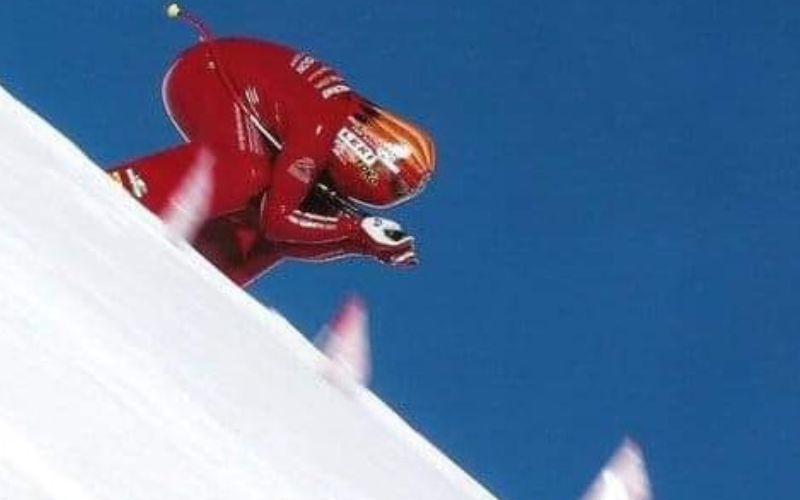
- Details
- By Elyse Wild
Last month, Ross Anderson (Cheyenne, Arapaho, and Mescalero-Chiricahua Apache) stood before a crowded room in the mountains of Utah. In his left hand, he held an eagle feather. Around his neck, there was a shining medal.
The moment was historic, for it marked Anderson’s induction into the U.S. Ski and Snowboarding Hall of Fame — making him the first Native American to receive the honor.
Anderson, a record-holding speed skier, recounted moments from his career and acknowledged his colleagues and supporters. He finished with a nod to Indian Country and a message for young Natives.
“I will say this to Indian Country: Never let anyone tell you that you can’t,” Anderson told the crowd. He held the eagle feather aloft, and the room was filled with the thundering sound of applause and a standing ovation.
‘I was determined I was going to be that person.’
Anderson was raised by adoptive parents in Durango in southwest Colorado. He grew up skiing at the nearby Purgatory Ski Resort, a year-round resort with 1,600 acres of skiable terrain, 107 trails, 11 lifts, and a vertical drop of 2,029 feet.
Anderson remembers first hitting the slopes as a toddler with a rope tied around his waist and held by an adult to keep him from falling too hard. He loved skiing but didn’t see many others who looked like him on the slopes or in the sport’s professional ranks, where most competitors are white.
“It was kind of hard for me,” Anderson said. “There were skiers I idolized, but as far as someone to look up to that I really wanted to be, I didn’t see my identity during that time. That’s where I struggled a lot growing up, you have people you root for but not people you really want to be. I determined that I was going to be that person.”
In 1993, when Anderson was 22 years old, a friend introduced him to speed ski racing, a sport involving skiing as fast as possible over a fixed slope. Professional speed skiers regularly break speeds of 120 miles per hour.
Anderson bought a motorcycle helmet at a local pawnshop and drove to Tahoe Donner Ski Area in California for his first competition. He was the slowest racer that day, but he committed to his craft. He would go on to win eight national titles in speed skiing and take bronze at the World Championship in 2005. In 2006, he would earn a title he still holds today: the fastest American on skis.
 Anderson in speed skiing Vars, France. (photo/Tam-Tam Photography)
Anderson in speed skiing Vars, France. (photo/Tam-Tam Photography)
154.06 mph
It’s been 18 years since Anderson earned that title. He recalls it with pinpoint accuracy.
“The spectators just look like little dots,” Anderson said, describing what he saw as he stood at the head of the one-mile-long racing slope in 2006 at a Speed Ski World Cup in the French Alps.
He picked up speed down the mountain, describing his run as a near metaphysical experience, surpassing 120 miles per hour — the speed at which someone falls out of a plane — and feeling a sense of calm.
“It’s an out-of-body experience,” he said. “When you are that focused and in the zone, you don’t really hear or see anything around you.”
When he crossed the finish line, he didn’t know what to think about his top speed. He saw a jumbotron in the distance, displaying his speed.
“I couldn’t really see it at first, and it was in kilometers,” he said. “And then I saw 247.09 kilometers per hour, which is 154.06 miles per hour. I thought, ‘No way!’”
 Anderon holds an eagle feather aloft at last month's ceremony. (photo/Greg Winkels)The former record was 153.03 mph, held by speed skier John Hemble. Each fraction of a mile per hour, Anderson says, is cultivated from years of practice.
Anderon holds an eagle feather aloft at last month's ceremony. (photo/Greg Winkels)The former record was 153.03 mph, held by speed skier John Hemble. Each fraction of a mile per hour, Anderson says, is cultivated from years of practice.
“It doesn’t happen overnight, it takes years and years,” he said.
This April 19 will mark 18 years that Anderson has held the record. Today, he lives in New Mexico, where he was born. Last year, he appeared in a commercial promoting tourism in the state. He was skiing.
“I was never afraid to go fast,” he says. The commercial footage shows him in his red downhill suit and helmet embellished with an eagle feather design. He’s charging down New Mexico’s Alto Mountain, positioned in the signature low tuck of a speed skier.
According to Snowsports Industry American, 68.7% of skiers in the 2019-2020 season were white. With a high cost of entry — the cost of basic equipment runs at least $500 and a weekend lift ticket costs about $142 — the sport isn’t accessible to many young Native Americans.
Anderson hopes to help create pathways for Native youth and people of color to access skiing and snowboarding. When he was a young skier, he received assistance from Running Strong for Native Youth, a foundation founded by Olympic Gold Medalist Billy Mills (Oglala Lakota) to support Native youth.
“Creating more affordable ways to get into the sport would be beneficial to all people of color — from the suburbs to the reservations — (and) for people that have the mentality of a dreamer,” he said. “I want to be part of changing it for the better.”
More Stories Like This
Zuni Youth Enrichment Project Takes Top Emerging Artist Apprentices to Phoenix for Artistic Exploration and Cultural ImmersionFrom Dishwasher to Award-Winning Chef: Laguna Pueblo's Josh Aragon Serves Up Albuquerque's Best Green Chile Stew
Rob Reiner's Final Work as Producer Appears to Address MMIP Crisis
Vision Maker Media Honors MacDonald Siblings With 2025 Frank Blythe Award
First Tribally Owned Gallery in Tulsa Debuts ‘Mvskokvlke: Road of Strength’
Help us defend tribal sovereignty.
At Native News Online, our mission is rooted in telling the stories that strengthen sovereignty and uplift Indigenous voices — not just at year’s end, but every single day.
Because of your generosity last year, we were able to keep our reporters on the ground in tribal communities, at national gatherings and in the halls of Congress — covering the issues that matter most to Indian Country: sovereignty, culture, education, health and economic opportunity.
That support sustained us through a tough year in 2025. Now, as we look to the year ahead, we need your help right now to ensure warrior journalism remains strong — reporting that defends tribal sovereignty, amplifies Native truth, and holds power accountable.
 The stakes couldn't be higher. Your support keeps Native voices heard, Native stories told and Native sovereignty defended.
The stakes couldn't be higher. Your support keeps Native voices heard, Native stories told and Native sovereignty defended.
Stand with Warrior Journalism today.
Levi Rickert (Potawatomi), Editor & Publisher


